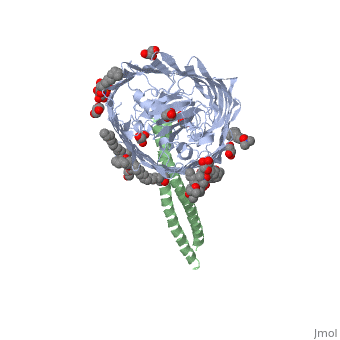Colicin E3: Difference between revisions
No edit summary |
No edit summary |
||
| Line 1: | Line 1: | ||
Colicin E3 is a type of [[Colicin]], a bacteriocin made by ''E. | Colicin E3 is a type of [[Colicin]], a 60kDa<ref> PMID: 7809274 </ref> bacteriocin made by ''E. coli'' which acts against other nearby ''E. coli'' to kill them with its 16s rRNase activity; it digests the 16s ribosomal subunit, ultimately leading to the death of the cell. | ||
==Synthesis and release== | ==Synthesis and release== | ||
When colicin E3 is synthesised, it binds its | When colicin E3 is synthesised, it binds its 10kDa<ref> PMID: 7809274 </ref> [[Colicin Immunity Protein]], [[Im3]], to its cytotoxic domain in the cytoplasm. This prevents its RNase activity from occurring in the colicinogenic host, so it does not kill it<ref> PMID: 3889348 </ref>. It is released as this complex into the surrounding area, and Im3 is only released upon binding to a target cell. | ||
==Mechanism of uptake== | ==Mechanism of uptake== | ||
| Line 13: | Line 13: | ||
==Killing Activities== | ==Killing Activities== | ||
{{STRUCTURE_2xfz | PDB=2xfz | SCENE= }} | {{STRUCTURE_2xfz | PDB=2xfz | SCENE= }} | ||
The C terminal domain of colicin E3 kills the cells that it penetrates by actively degrading the 16s rRNA subunit of the cell's 70S ribosome. This prevents the cell from producing any proteins once attacked, which will lead to the death of the cell. | |||
==References== | ==References== | ||
<references/> | <references/> | ||
Revision as of 16:49, 10 February 2011
Colicin E3 is a type of Colicin, a 60kDa[1] bacteriocin made by E. coli which acts against other nearby E. coli to kill them with its 16s rRNase activity; it digests the 16s ribosomal subunit, ultimately leading to the death of the cell.
Synthesis and releaseSynthesis and release
When colicin E3 is synthesised, it binds its 10kDa[2] Colicin Immunity Protein, Im3, to its cytotoxic domain in the cytoplasm. This prevents its RNase activity from occurring in the colicinogenic host, so it does not kill it[3]. It is released as this complex into the surrounding area, and Im3 is only released upon binding to a target cell.
Mechanism of uptakeMechanism of uptake
| |||||||||
| 1ujw, resolution 2.75Å () | |||||||||
|---|---|---|---|---|---|---|---|---|---|
| Ligands: | , , , , | ||||||||
| Related: | 1nqe, 1jch | ||||||||
| |||||||||
| |||||||||
| Resources: | FirstGlance, OCA, PDBsum, RCSB | ||||||||
| Coordinates: | save as pdb, mmCIF, xml | ||||||||
ColE3 initially binds to the BtuB vitamin B12 receptor. Formation of this complex leads to the unfolding of the N terminal receptor binding coiled-coil domain of ColE3. [4]
The structure shows the complex formed between BtuB and the ColE3 translocation domain [5]
Killing ActivitiesKilling Activities
The C terminal domain of colicin E3 kills the cells that it penetrates by actively degrading the 16s rRNA subunit of the cell's 70S ribosome. This prevents the cell from producing any proteins once attacked, which will lead to the death of the cell.
ReferencesReferences
- ↑ Chak KF. Expression of the ColE3 operon in maxicells. Proc Natl Sci Counc Repub China B. 1993 Apr;17(2):41-7. PMID:7809274
- ↑ Chak KF. Expression of the ColE3 operon in maxicells. Proc Natl Sci Counc Repub China B. 1993 Apr;17(2):41-7. PMID:7809274
- ↑ Masaki H, Ohta T. Colicin E3 and its immunity genes. J Mol Biol. 1985 Mar 20;182(2):217-27. PMID:3889348
- ↑ Masi M, Vuong P, Humbard M, Malone K, Misra R. Initial steps of colicin E1 import across the outer membrane of Escherichia coli. J Bacteriol. 2007 Apr;189(7):2667-76. Epub 2007 Feb 2. PMID:17277071 doi:10.1128/JB.01448-06
- ↑ Kurisu G, Zakharov SD, Zhalnina MV, Bano S, Eroukova VY, Rokitskaya TI, Antonenko YN, Wiener MC, Cramer WA. The structure of BtuB with bound colicin E3 R-domain implies a translocon. Nat Struct Biol. 2003 Nov;10(11):948-54. Epub 2003 Oct 5. PMID:14528295 doi:10.1038/nsb997

